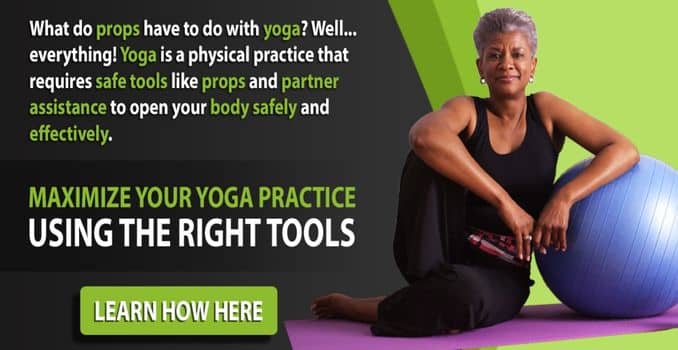Chest yoga poses focus on creating space and freeing energy in the heart center. This yoga practice is about opening up the chest, expanding the rib cage, and creating a sense of lightness and freedom in the heart area. It's a powerful way to release tension and stress and to connect more deeply with your emotions and inner self. Heart and chest yoga poses are a wonderful way to cultivate a deeper sense of self-love and compassion. Here are a few poses to maximize the benefits of heart and chest-opening yoga.
Importance of Heart and Chest Opening Yoga Postures
Heart and Chest Opening Yoga practices are often emphasized in various forms of yoga, meditation, and mindfulness practices. These yoga poses involve stretches and movements that target the chest and shoulder area, promoting physical, mental, and emotional well-being.
Practitioners can also incorporate heart-opening affirmations and visualizations into their practice, such as imagining a bright light emanating from the heart center.
You may join a community of yogis with a professional yoga teacher to help you motivate performing yoga. Yoga teachers often incorporate these poses in their yoga classes to encourage self-expression, release tension, and foster a sense of openness and connection within their students.
The primary benefits of heart and chest yoga postures:
1. Creating space and freeing energy in the heart center
In yoga, the chest is referred to as the ‘heart center' or ‘Anahata chakra,' which is believed to be the center of emotions, love, compassion, and forgiveness.
-
- When we practice heart and chest-opening yoga poses, we expand the chest area, creating more physical space in the chest cavity. This increased space can lead to better breathing and circulation, improving overall health and wellness.
- It can stimulate the thymus gland, which is responsible for producing T-cells, a type of white blood cell that helps energy boost the immune system.
2. Opening up the chest and expanding the rib cage
Heart and Chest oga exercises can help open up the chest and expand the ribcage by stretching and strengthening the muscles in the chest and back. These exercises can also improve breathing by allowing the lungs to expand fully and efficiently.
3. Cultivating lightness and freedom in the heart area
The physical benefits of Heart and Chest Opening Yoga exercises can also have an emotional impact. As the chest opens up and becomes more expansive, individuals may experience feelings of lightness and freedom, both physically and emotionally, leading to a greater sense of confidence, self-awareness, and overall well-being.
4. Releasing tension and stress
One effective way to release tension and stress is by practicing deep breathing exercises while gently rolling your shoulders back and down, allowing the tension to melt away from your shoulder blades.
Heart and Chest Opening Yoga poses can release tension and stress in several ways.
a. Opening the chest and expanding the lungs, the physical body can take in more oxygen and release more carbon dioxide. This helps calm the nervous system and reduces stress levels.
b.The exercises can help release tension in the chest, shoulders, and neck muscles, reducing tension and promoting relaxation. Many people hold tension in these areas, that leads to pain and discomfort.
5. Connecting with emotions and inner self
Learning and teaching yoga provides a powerful avenue for individuals to connect with their emotions and inner self, fostering a deeper understanding and appreciation of their journey. Heart and Chest Opening Yoga poses connect with emotions in some ways that include:
a. These exercises can help to increase feelings of openness, vulnerability, and love. Physiologically, this can promote the release of oxytocin, a hormone associated with feelings of bonding and connection. This can be particularly helpful for individuals dealing with deep-seated emotional issues or trauma.
b. Each yoga practice often involves breathing techniques that may help regulate the nervous system and reduce anxiety.
6. Cultivating self-love and compassion
Heart and chest yoga exercises can help individuals to release emotional blockages and pain that may be stored in the chest and heart area. By releasing these emotions, individuals can experience greater self-awareness and self-acceptance, which increases self-love and compassion.
7. Help improve posture and breathing
When the chest is open and the shoulders are relaxed, it is easier to take deep breaths and fill the lungs with oxygen improving respiratory health and increasing energy levels.
8. Corrects Rounded shoulders
Practicing heart-opening yoga can help alleviate rounded shoulders, a common postural problem caused by poor posture habits, such as slouching or hunching forward while sitting or standing, by strengthening and stretching the muscles in the upper back, chest, and shoulders.
Heart and Chest Opening Poses
1. Progressive Exercises #1
A. Supported Reclined Butterfly Pose – Heart Opener
For this exercise, use a bolster, yoga block, cushion, or pillow that can support your upper body comfortably.
Lie on your back on the floor with your knees bent and feet flat on the floor. Place the bolster lengthwise under your upper body and rest your arms out to the sides. Bring the soles of your feet together, tighten your core, and open your knees. Hold the position for 5 deep belly breaths, in through your nose and out through your mouth. Relax and return to the starting position.
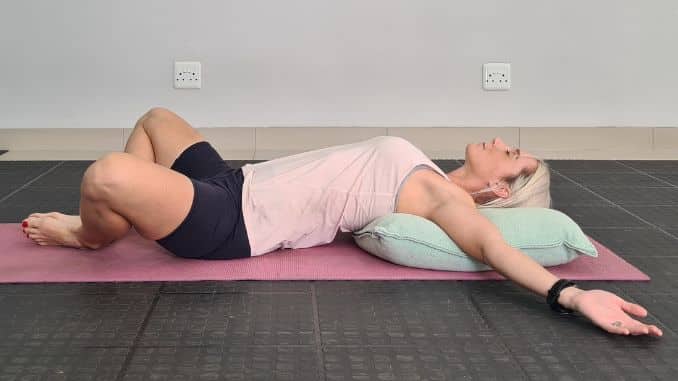
B. Supported Reclined Butterfly with Angel Arms
From the Supported Reclined Butterfly pose, inhale and slowly bring your arms overhead in wide arcs. Exhale and reverse the movement to lower your arms to the starting position. Repeat the movement, similar to a snow angel movement. Start with 1 set of 4 repetitions. Relax and return to the starting position.
The use of props, such as a bolster or blanket to support the back or hips, allows for a comfortable and sustained stretch.
Some of the advantages of this pose are:
-
- Relieves stress and anxiety
- Relieves discomfort in the upper and lower regions of the back.
- Promote a smooth and effortless flow of prana (life force) in a downward direction
The gentle stretch and opening of the chest, combined with the deep breathing required in this pose, can also help in opening up the hips and groin area, which can be particularly beneficial for individuals who spend long hours sitting or have tight hip muscles. Other benefits include:
-
- Improves blood circulation. The pose can improve blood circulation by opening the chest and expanding the rib cage.
-
- Alleviates menstrual cramps
- Enhance breathing and lung capacity
- Supports healthy digestion, regulates hormonal imbalances, and enhances overall abdominal health
The pose relaxes the body and mind, making it a significant way to wind down before bed and promote better sleep.
Transition Exercise:
Prone Position
Lie on your stomach with your feet hip-width apart, maintaining good alignment with your head, shoulders, hips, and legs. Bend your elbows out to the sides and turn your head to rest your check on top of your hands. Close your eyes and take deep belly breaths, in through your nose and out through your mouth, relaxing your upper body.
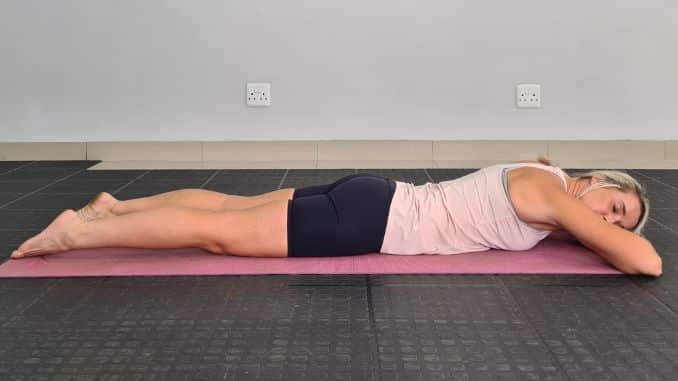
To make the exercise more comfortable, place a bolster or pillow underneath your belly for support if needed. Or, to make the exercise more challenging, rock your hips from side to side to release tightness in the low back area.
Several advantages are associated with this pose, including:
-
- Improved oxygenation (supplying oxygen to the body's cells)
- It can help quiet the mind and promote a state of inner stillness and introspection
- Helps in aligning the spine by stretching and elongating the back muscles
- It can counteract the effects of hunching or slouching, which are common in modern lifestyles
The pose can be especially beneficial for patients who are critically ill or have respiratory distress. When a person is lying face down, the weight of the chest and abdomen is distributed more evenly, which can help to open up the airways and increase lung volume, leading to better oxygenation of the blood.
2. Sphynx Pose
From the Prone position, bring your elbows beneath your shoulders, spreading your fingers wide for a good base of support. Press and arch your back, using your glutes and back muscle strength. To intensify the stretch, move your forearms closer toward you and slowly pull yourself forward to open up your chest. Keep your hips anchored into the mat. Hold this position for a couple of breaths, in through your nose and out through your mouth. Relax and return to the starting position.
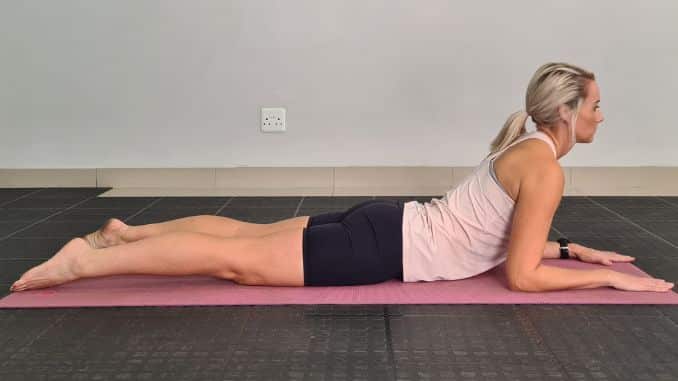
Depending on your comfort level, repeat a1.Prone Position.
The Sphynx Pose is excellent for stretching and strengthening the lower back, chest, and torso muscles. Other benefits are:
- Helps to increase the flexibility and mobility of the spine
- Stimulates the abdominal organs and may aid digestion
- It activates the core muscles, including the abdominals and lower back, leading to improved core strength and stability
- Allows for deeper breathing and expansion of the lungs. It can enhance lung capacity and improve overall respiratory function
Sphynx Pose can also strengthen the muscles around the spine, which helps to improve posture and reduce back pain. Strong muscles around the spine also help to support the body during other physical activities.
3. Flapping Fish Position
For this exercise, use a bolster or pillow to support your head.
Lie on your stomach with your feet shoulder-width apart, maintaining good alignment with your head, shoulders, hips, and legs. Bend one knee out to the side, ideally 90 degrees away from your body. Lift your upper body just enough to bring your opposite arm towards your bent knee. Twist your upper body upward to rest your head on the bolster and extend your other arm behind you. Close your eyes as you hold this position for several deep belly breaths, in through your nose and out through your mouth. Return to the starting position and repeat the movement on the opposite side.

Flapping Fish pose is a yoga asana with numerous physical and mental benefits. Here are some of them.
- Improves Posture: Flapping Fish Pose stretches the chest, neck, and shoulders and strengthens the upper back muscles. This helps improve posture and reduce back and neck pain.
- Relieves Stress and Anxiety: The deep breathing involved in this pose helps calm the mind and reduce stress and anxiety. It also helps improve focus and concentration.
- Stimulates the Thyroid Gland: The pose also stimulates the thyroid gland, which regulates metabolism and energy levels.
4. Supported Child’s Pose
For this exercise, use a bolster or pillow to support your head.
Begin in an upright kneeling position in front of the bolster with your knees wider than shoulder-width apart. Tighten your abdominal area. Shift your hips back to your feet and bring your elbows on the outside of the bolster, resting your one check on top of your hands. Relax your midback area for a light stretch. Close your eyes and take several deep belly breaths, in through your nose and out through your mouth. Relax and return to the starting position.
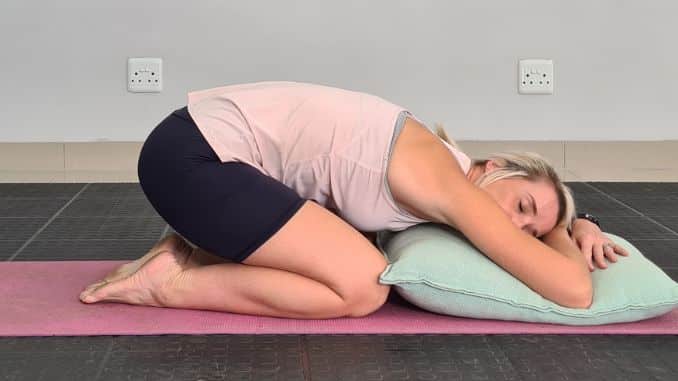
Advantages of Supported Child's pose:
- Relieves tension in the back, neck, and shoulders: The poses gently stretch the neck, shoulders, spine, and back, helping to release tension and stiffness in these areas.
- Improves digestion: It can alleviate digestive discomfort and bloating and improves the functioning of the digestive system.
- Increases flexibility: Regular practice of this pose helps improve flexibility in the hips, thighs, and ankles.
- Enhances relaxation and sleep quality: This pose promotes relaxation and better sleep quality, making it a great choice for those with difficulty sleeping.
5. Heart Opener
Begin in an upright kneeling position with your knees and feet close together, maintaining good alignment with your head, shoulders, and hips. Shift your hips back to rest your seat on your feet. Interlace your fingers behind your back and engage your core. Press your joined hands down, look up, and hold this position for a few deep belly breaths, in through your nose and out through your mouth. Relax and return to the starting position.
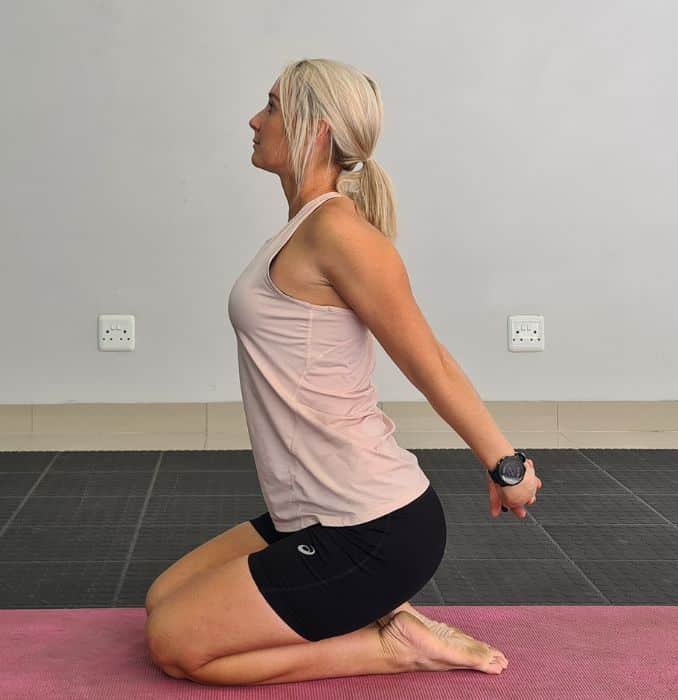
To make the stretch more comfortable, use a strap or towel to bridge the distance between your hands if needed and hold the position for a few deep belly breaths.
- The primary benefit of a Heart Opener chest yoga poses is to open up the chest, shoulders, and heart center. These postures stretch and strengthen the muscles in these areas, reducing tightness and shoulder and neck pain.
- It can help increase lung capacity and improve breathing. When the chest is open, it permits deeper, fuller breaths, which can be especially helpful for those with respiratory issues.
- Some people also find that practicing heart openers can have an uplifting effect on mood by stimulating the release of endorphins and increasing energy levels
6. Camel Pose
Begin in an upright kneeling position with your feet close together, maintaining good alignment with your head, shoulders, hips, and knees. Engage your core. Lean your upper body back, look up, and plant your hands on your hips. Push your hips forward so that your hips are aligned with your knees. Hold this position for three deep belly breaths, in through your nose and out through your mouth. Relax and return to the starting position.
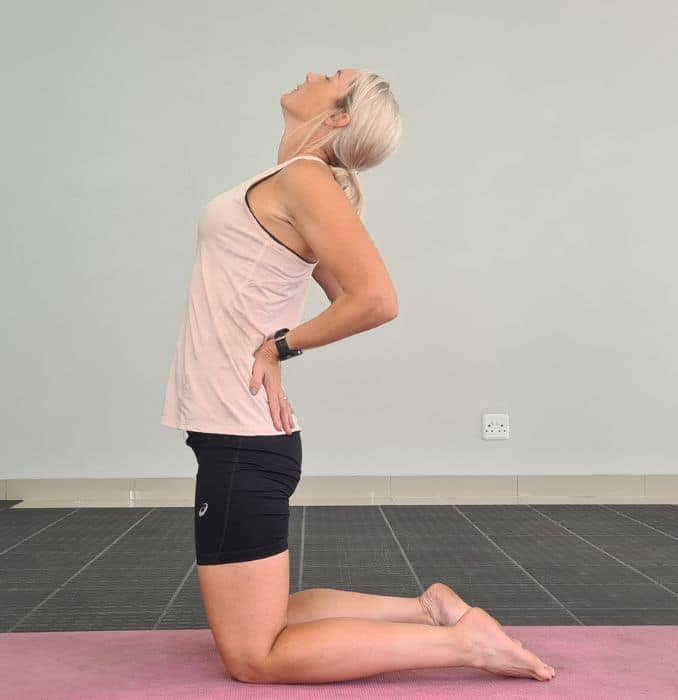
- The primary benefit of a Camel Pose is to stretch and open the shoulders, chest, and throat while also strengthening the back muscles.
- This pose can also improve posture and flexibility in the spine and lower body.
- It can stimulate the digestive organs and improve digestion by compressing the abdomen and releasing fresh blood flow to the digestive system. It may help alleviate digestive issues like constipation and bloating.
- Regular practice can enhance mindfulness and concentration, promoting a sense of calm and mental clarity
Aside from the Camel Pose, you can also perform the Bow Pose, Cobra Pose, and Dance Pose. Bow Pose strengthens the back muscles, improves posture, and stimulates the digestive system. Bow Pose is particularly beneficial for people who spend long hours sitting or standing. Dance Pose is another yoga pose that offers multiple benefits. It is a significant way to build strength and flexibility while improving mental focus and concentration. Meanwhile, the Cobra Pose is a popular yoga pose that is great for improving posture, strengthening the back muscles, and relieving tension in the shoulders and neck.
7. Extended Prayer with Breaths
Begin in an upright kneeling position with your knees and feet close together, maintaining good alignment with your head, shoulders, and hips. Close your eyes and hold your arms out at your sides with your palms facing outward. Engage your core, take a deep belly breath in through your nose, lift your arms overhead in wide arcs, and press your palms together overhead. Exhale and lower your palms toward the heart center, bending your elbows out at your sides. Return to the starting position and repeat the sequence of movements.
Start with 3 repetitions, moving with the rhythm of your breath. If closing your eyes is too challenging, go through this exercise with your eyes open and focus your gaze on an unmoving point or object.
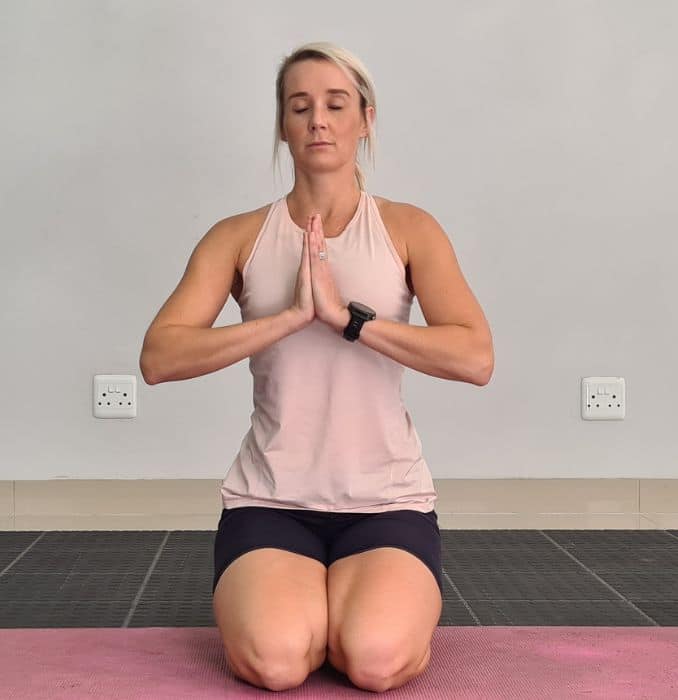
The primary benefit of this practice is bringing a sense of calmness and concentration to the mind and body. When the hands are brought together in a prayer position, it creates a sense of harmony between the right and left sides of the brain, which helps to balance the body's energy. This gesture also helps reduce stress and anxiety, promoting mindfulness and meditation.
Generally, each chest yoga poses helps to release tension and stress from the chest area, creating a sense of emotional and mental space. By regularly engaging in these exercises, individuals can release tension and tightness in the chest, improving posture and increasing overall flexibility. These are all essential in your everyday life.
Conclusion
Heart and Chest Opening Yoga is a powerful practice that holds the key to unlocking profound transformation within ourselves. As we venture on this journey, let us embrace the opportunity to connect deeply with our hearts, releasing any burdens or barriers that may have hindered our growth. By dedicating ourselves to this practice, we can experience the incredible benefits of expanded consciousness, heightened self-awareness, and an overwhelming sense of inner peace.
Through Heart and Chest Opening Yoga, we invite love, compassion, and vulnerability into our lives. So, let us embrace this practice wholeheartedly, knowing that our journey toward greater openness and expansion has the power to build our lives and the world around us.


